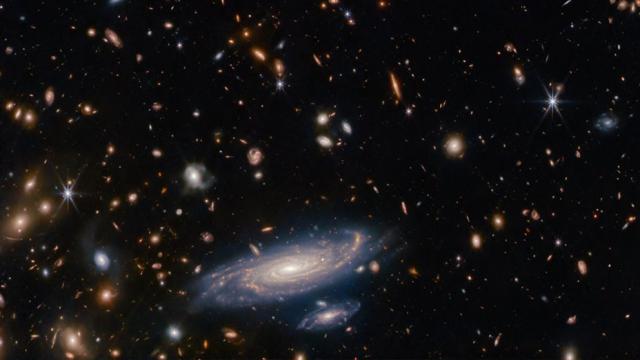In the beginning, galaxies were lacking in chemical and metal abundances, according to a team of astronomers that recently used a telescope to study the ancient universe.
Though the galaxies in the quarter-billion years seemed to follow the rules established by younger, previously observed galaxies regarding star formation rate and stellar mass, they had only a quarter the chemical abundance that was expected, the researchers found. The team’s research on the ancient galaxies was published last week in Nature Astronomy.
“It was like the galaxies had a rulebook that they followed—but astonishingly, this cosmic rulebook, appears to have undergone a dramatic rewrite during the universe’s infancy,” said study co-author Claudia Lagos, an astronomer at the International Centre for Radio Astronomy Research (ICRAR) and the Cosmic Dawn Center in Copenhagen in a University of Western Australia release.
The telescope was—of course—the Webb Space Telescope, a $US10 billion space observatory launched to space in December 2021 and which has been making scientific observations since July 2022. Webb observes the cosmos at infrared and near-infrared wavelengths, which makes it an ideal tool for studying the most ancient light we can see.
The farther out in the universe a telescope looks, the more the light it sees has been stretched (or “shifted”) to the redder side of the electromagnetic spectrum. Thus, in the parlance of astronomers, the light has been “redshifted.” This stretching is assigned a number, which scientists call “z.” The bigger the “z” number, the farther away (and thus, the older) the object is.
Until recently, the team noted, galaxies’ chemical abundances could only be reliably measured at redshifts of z=3.3 or less. But Webb allowed the recent team to measure such abundances at redshifts of z=7-10, or between 500 million years and 750 million years after the Big Bang.
The researchers used Webb’s far-reaching gaze to measure the rates of star formation, stellar masses, and chemical abundances of galaxies from the universe’s first few hundred million years of existence.
“The most surprising discovery was that ancient galaxies produced far fewer heavy elements than we would have predicted based on what we know from galaxies that formed later,” Lagos said. “The early galaxies continually received new, pristine gas from their surroundings, with the gas influx diluting the heavy elements inside the galaxies, making them less concentrated.”
The ancient galaxies aren’t even the most ancient Webb has seen. Last November the telescope spotted two galaxies with redshifts of approximately 10.25 and 12.5, rivalling the age of Maisie’s Galaxy, another galaxy spotted by Webb with a redshift of 11.8, or an age of about 13.4 billion years. Our universe is about 13.77 billion years old.
One of Webb’s main tasks is scrutinizing these ancient galaxies, to understand how they took form and evolved. Many of the ancient galaxies Webb has seen appear surprisingly mature, given their appearance in a nascent universe.
But the new research indicates the galaxies still have their secrets—in this case, an evident lack of heavy elements. More observations by Webb could help explain how these galaxies took shape, but expect more mysteries to arise on scientists’ search for clarity.
